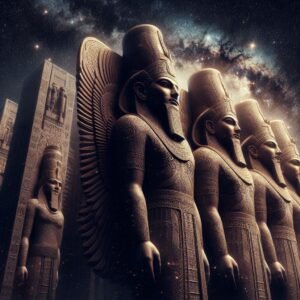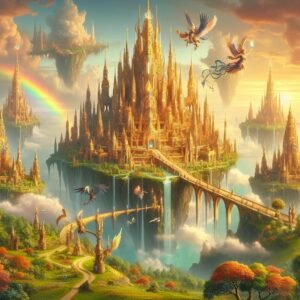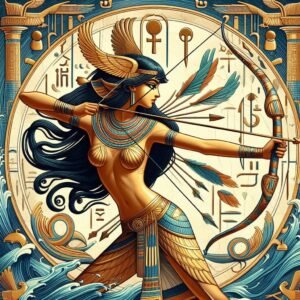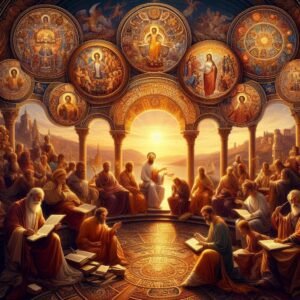
The term “Igigi” refers to a group of mythological figures in Mesopotamian mythology. They are often considered the younger gods who served the Anunnaki, the major deities. According to the Atrahasis myth, the Igigi were tasked with laborious work for the Anunnaki until they eventually rebelled due to the harsh conditions. This rebellion led to the creation of humans to take over the laborious tasks. The Igigi are sometimes mentioned interchangeably with the Anunnaki, but they are distinct in their roles and stories within Mesopotamian mythology.
They were often associated with celestial and heavenly duties, such as maintaining the physical and divine order of the cosmos, including the movements of celestial bodies
In addition to their laborious tasks, the Igigi held significant celestial responsibilities in Mesopotamian mythology. They were considered gods of heaven and the sky, with powers linked to various cosmic phenomena. The Igigi could command the winds, influence the movement of celestial bodies, and even tamper with the threads of fate within certain boundaries. Their roles extended beyond mere labor, highlighting their importance in maintaining the divine and cosmic order.
The Igigi, as gods of heaven and the sky, were believed to have significant control over various celestial and atmospheric phenomena, including the winds. They could command the winds to blow, influencing weather patterns and the climate. This control over the winds was part of their broader role in maintaining the cosmic order and ensuring the balance of natural forces. Their ability to manipulate the winds highlights their importance in Mesopotamian mythology as powerful deities who could impact both the heavens and the earth.
While the exact names and number of the Igigi are not definitively known, some sources suggest that gods like Ištar, Asarluhi, Naramṣit, Ninurta, Nuska, and Šamaš might have been part of this group.
Mythical appearances
In the Atrahasis myth, they are depicted as labouring to dig the Euphrates and Tigris rivers before rebelling against their harsh working conditions.
The Atrahasis myth is an ancient Mesopotamian epic that dates back to the 18th century BCE. It is named after its protagonist, Atrahasis, whose name means “exceedingly wise.” The myth is recorded on clay tablets and includes both a creation story and a flood narrative.
In the creation part of the myth, the gods divide the universe among themselves, with Anu taking the sky, Enlil the earth, and Enki the freshwater sea. The lesser gods, known as the Igigi, are tasked with labouring to maintain the earth, but they eventually rebel due to the harsh conditions. To solve this, the god Enki suggests creating humans to take over the labor. The mother goddess Mami creates humans from clay mixed with the blood of a slain god.
The flood narrative in the Atrahasis myth is one of the earliest known flood stories. The gods decide to send a flood to destroy humanity because they have become too noisy and disruptive. However, Enki warns Atrahasis and instructs him to build an ark to save himself, his family, and animals. Atrahasis follows these instructions, and after the flood, he offers a sacrifice to the gods, who then agree to never again send such a flood.
The Igigi are also mentioned in the Epic of Gilgamesh, where they are involved in the creation of the Bull of Heaven, which is sent to punish Gilgamesh.
The Bull of Heaven holds significant symbolic meaning in Mesopotamian mythology. It represents divine retribution and the immense power of the gods. The Bull is sent by the goddess Ishtar (Inanna) to punish Gilgamesh after he rejects her advances. This act of sending the Bull highlights the gods’ ability to intervene directly in human affairs and serves as a reminder of the consequences of defying divine beings.
The battle with the Bull of Heaven also underscores themes of heroism and mortality. Gilgamesh and his companion Enkidu manage to slay the Bull, but this victory comes at a great cost. The gods decree Enkidu’s death as punishment for killing the Bull, which profoundly impacts Gilgamesh and sets him on a quest to understand mortality and seek immortality. Thus, the Bull of Heaven is a pivotal element in the epic, driving the narrative forward and deepening its exploration of human and divine relationships.
Additionally, in some versions of the ancient Sumerian myth “The Descent of Inanna,” the Igigi are depicted as celestial beings who observe Inanna’s perilous journey to the underworld. The Igigi, often considered lesser gods or divine beings, play a role in the celestial hierarchy, distinct from the Anunnaki, who are more directly involved in earthly affairs. As Inanna, the goddess of love, beauty, and war, descends into the underworld to visit her sister Ereshkigal, the Queen of the Dead, the Igigi watch from the heavens, symbolizing the cosmic significance of her journey. Their presence underscores the importance of Inanna’s descent and the balance between life and death, heaven and earth.
Inanna’s journey to the underworld is a profound and symbolic tale. She begins by adorning herself in her finest garments and divine regalia, symbolizing her power and status. As she descends, she passes through seven gates, each guarded by a gatekeeper who demands that she relinquish a piece of her attire. This act of stripping away her garments represents the shedding of her earthly power and ego.
Upon reaching the underworld, Inanna is brought before her sister, Ereshkigal, the Queen of the Dead. Ereshkigal is not pleased to see her and orders her execution. Inanna is judged, killed, and her corpse is hung on a hook. This dramatic moment symbolizes the ultimate surrender and the inevitability of death.
However, Inanna’s story does not end in the underworld. Her faithful servant, Ninshubur, follows her instructions to seek help from the gods. Eventually, Enki, the god of wisdom, intervenes and sends two beings to revive Inanna with the “food and water of life.” Inanna is resurrected and allowed to return to the world of the living, symbolizing rebirth and the cyclical nature of life and death.
Subscribe to our post updates - Don't miss a thing!!







